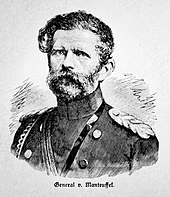Southern Army (Franco-German War)
The Southern Army was a major German association during the Franco-Prussian War . It was activated in January 1871 in the final phase of the war and carried out combat operations against the French Bourbaki army from the Jur Mountains to the Swiss border .
history
Lineup
On January 12, 1871, levies from the 1st Army and the 2nd Army formed a newly formed southern army. General v. Manteuffel , the headquarters were in Châtillon . Colonel Hermann Ludwig von Wartensleben acted as chief of the general staff , the southern army consisted of the following major units:
II Army Corps under Infantry General Eduard von Fransecky
- 3rd Infantry Division : Major General Ernst von Hartmann
- 4th Infantry Division : Lieutenant General Benno Hann von Weyhern
VII Army Corps under Infantry General Heinrich Adolf von Zastrow
- 13th Infantry Division : Lieutenant General Ludwig von Bothmer
- 14th Infantry Division : Lieutenant General Ernst Wilhelm Schuler von Senden
- Dannenberg Uhlan Brigade (later Colonel Knesebeck)
XIV Army Corps under Infantry General August von Werder
- Baden division under General Adolf von Glümer
- 1st Reserve Division: General Udo von Tresckow
- 4th Reserve Division: General Wilhelm von Schmeling
- Detachment von der Goltz (one infantry and one cavalry brigade)
- Debschitz Detachment (8 Landwehr battalions, 2 cavalry squadrons)
Campaign in the French Jura
Since the Baden XIV. Army Corps under General Werder needed help against the French Eastern Army , the army set out on the same day through the Jura Mountains to rush to the corps' aid.
On January 2, 1871, the II Corps resigned from the Paris siege front and entered under the command of the Southern Army. On January 17th Fransecky's troops reached the heights of the Côte d'Or, on the 19th the corps crossed the Saone at Gray . When Manteuffel had crossed the mountains, he received the news that the Eastern Army was withdrawing. In order to disrupt General Bourbaki's lines of retreat , Manteuffel and his army turned to the right. The VII Corps reached Sauvigny on January 19th and Dampierre on the 20th while advancing on Besançon . Manteuffel had ordered further action on Pontarlier , where Bourbaki's army, now led by General Justin Clinchant , was suspected. On January 25, the XIV. Corps , marching from the east via Rioz , reached the connection to the Southern Army and cleared the 14th Division of the VII. Corps in the Besançon area. The Germans had succeeded in relocating Bourbakis' return route west and south-west of Besançon and cutting off the rail links to Lyon .
On January 30, the 1st Army received news that Paris had surrendered and a 21-day armistice had been concluded. However, the local departments were not affected by this and the southern army was to continue its operations until a complete decision was reached. After the victory in the battle at Frasnes, the 2nd Army Corps pushed on to Pontarlier. On the 31st, the VII Army Corps, operating in parallel, occupied Chantrans and blocked the road from Ontrans to Pontarlier for the French. While the II. Corps pursued further, the VII. Corps remained as an inactive spectator of the final act.
On February 1st at 12 noon General von Manteuffel ordered the attack on Pontarlier because he assumed that a mixture of all enemy corps had gathered here and that only weak detachments had so far withdrawn to St. Laurent . The II. And VII. Corps side by side, the Goltz detachment remained east of Levier as support and the von Schmeling division (4th reserve division) advanced to the left of the VII. However, on the night of the 1st General Clinchant had already reached an agreement with the Swiss authorities to transfer his army for the following day. Only the French 18th Corps secured the withdrawal.
The VII Army Corps remained an inactive spectator of the final act, in which the last great French army crossed into Switzerland and was thus destroyed. On March 6, it received orders to go the next day in the direction of Châtillon-sur-Saône and to occupy the departments of Meuse, Vosges and the parts of Meurthe and Moselle that remained French. The order to withdraw the 1st Army from France arrived at the end of May 1871.
literature
- v. Dambrowski: Modern history of the infantry regiment Prince Friedrich of the Netherlands together with an outline of the prehistory of the regiment. Hanover 1878, Helwingsche Verlagbuchhandlung.
- Alfred Cramer : History of the infantry regiment Prince Friedrich of the Netherlands (2nd Westphalian) No. 15. Berlin 1910, Verlag R. Eisenschmid, publishing house for military science.
- Justus Scheibert : The war between France and Germany 1870-1871. Based on the large general staff publisher by W. Paulis successor (H. Jerosch), Berlin 1895.
Individual evidence
- ↑ Justus Scheibert: War between France and Germany, W. Paulis successor, Berlin 1895, p. 307


